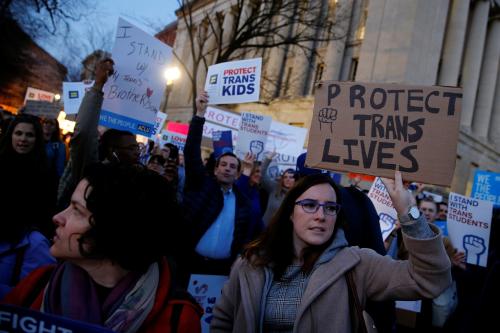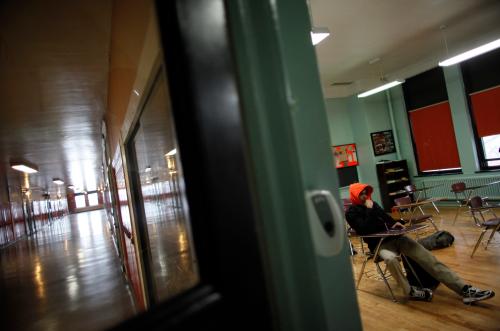In April, the California Court of Appeal overturned the trial court’s ruling in Vergara v. California[i], in which a group of families had challenged the constitutionality of state laws governing teacher tenure.[ii] (California state law automatically grants tenure to teachers after sixteen months, provides extra due process protections to teachers over and above those available to other state workers, and requires schools to use seniority rather than competency in layoff decisions.) The Court of Appeal acknowledged that the challenged statutes increase the number of ineffective teachers in California schools and that low-income and minority students in California are disproportionately taught by less effective teachers. Yet the court reasoned that it is the administrative decisions of district leaders—rather than the challenged statutes—which bear the ultimate responsibility for how teachers are distributed across the state.
However, the Court of Appeal failed to grasp the degree to which the tenure laws and the teacher labor market constrain districts’ choices. Even if local personnel policies might partially buffer the impact on low-income children by re-assigning ineffective teachers and paying effective teachers to take their place, such salary incentives are expensive (with the costs being borne disproportionately by schools serving low-income children) and have been only partially effective where they have been tried. When state law essentially guarantees public employment for ineffective teachers in California, low-income families pay one way or another—either in the form of salary incentives to retain and redistribute effective teachers, reductions in other services required to pay for those salary incentives, or because such policies usually fail to completely offset the burden, in terms of the lowered achievement of their children.
The Court of Appeal decision
The Court of Appeal summarized its ruling as follows:
“Although the statutes may lead to the hiring and retention of more ineffective teachers than a hypothetical alternative system would, the statutes do not address the assignment of teachers; instead, administrators—not the statutes—ultimately determine where teachers within a district are assigned to teach.” (p. 6)
Later in its opinion, the Court stated its view of the crux of the case:
“Plaintiffs still could have demonstrated a facial equal protection violation, however, by showing that the challenged statutes, regardless of how they are implemented, inevitably cause poor and minority students to be provided with an education that is not ‘basically equivalent to’ their more affluent and/or white peers.” (p. 32)
Inevitable harm
So, do the challenged statutes “inevitably cause” poor and minority students to be provided with a lower quality education?
The answer is yes. The negative impact can take two forms, depending on the district leadership’s response to the statutes: First, if the district leadership chooses not to intervene in the flow of teachers moving between its own schools and between districts, ineffective teachers will accumulate in the lowest-income schools and the lowest-income districts. How? As has been well documented, low-income schools and districts are at a disadvantage in the teacher labor market. When given the chance, teachers transfer out of schools with higher proportions of minority and disadvantaged students.[iii] Experienced teachers with better track records find it easier to find jobs elsewhere and the weakest teachers accumulate in the employers of last resort—low-income schools and districts. This mechanical process—dubbed the “Dance of the Lemons” by administrators—inevitably leads to a disproportionate glut of ineffective teachers at low-income schools and districts.
The second way in which the negative effects can be felt, however, is when district leaders do take counter-measures (precisely as the Court of Appeal envisions)—because such measures are expensive (and only partially effective). Theoretically, at least, school districts could simply re-assign their ineffective teachers to higher income schools. However, because of contracts and terms of employment, often collectively bargained, school districts cannot simply force effective teachers to move to high-needs schools to take the place of their less effective colleagues. School districts must compensate their best teachers to work with the students most in need. Unfortunately, such costs would be higher for districts with larger numbers of low-income students.
Likewise, although a given district need not allow its best teachers to transfer from low-income to high-income schools within their own district, they cannot bar those same teachers from moving to neighboring school districts or to private schools. If they want to keep them, they must incentivize them to stay. No amount of administrative skill could eliminate the costs to low-income districts of having to re-allocate or retain their more effective teachers to work with their most needy students.
Moreover, even where districts have taken these steps in an effort to buffer the impact on their lowest achieving students, such policies have been only partially effective. Recently, Glazerman et al. reported that even after being offered a $20,000 bonus to move to a high-need school in their district, only 3.5 percent of middle school teachers in the top quintile of effectiveness and 7 percent of similarly ranked elementary teachers were willing to transfer.[iv] Clotfelter et al. found that an $1800 bonus targeted at math, science, and special education teachers working in high-poverty or low-achieving secondary schools in North Carolina reduced turnover by 5 percentage points, or 17 percent.[v] In California, Steele et al. found that a $20,000 bonus to high achieving teaching candidates to work in high poverty schools increased the probability of their placement in a high-poverty school by 28 percent and their probability of remaining in the high-poverty school at the end of four years was similar to other teachers in those schools.[vi] However, it was a small program, providing less than a 1000 scholarships per year.
Each of these partially successful demonstrations required additional expenditures. Thus, even if school districts did succeed in reducing the gap in access to effective teaching with their own personnel policies, they would inevitably have to reduce other services to pay for them, e.g., larger class sizes, or lower base salaries. (The reformed California school finance system constrains districts’ ability to supplement spending through taxes.) In other words, when California law forces schools to retain ineffective teachers, low-income students pay one way or another, either in the quality of the teachers in their classrooms or in the redirection of resources they would have for other expenditures (or both).
The parallel role of market preferences in Serrano and Vergara
The Court of Appeal drew a distinction between what it saw as the direct implications of a law and the real world constraints shaping the way the law is implemented. In the school finance cases in California three decades ago, the Court of Appeal reasoned that negative consequences “inevitably flowed” onto low-income residents as a result of the law alone, since, they argued, property-tax funded education inevitably disadvantaged low-income people.
However, they failed to note the role that market preferences played in mediating that effect. It may be self-evident that low-wealth communities would be disadvantaged by laws requiring local financing of schools. But there would be no low-income (or high-income) communities if there were no segregation by income and race in the housing market. If every neighborhood were integrated and there were no relationship between the local tax base and a person’s income, then low-income families would not be disadvantaged by local financing of schools.
In the Serrano cases, it was the state’s reliance on local property taxes to pay for education, combined with the residential preferences of higher-income homeowners, which left low-income households with a smaller tax base to fund their schools.[vii] In the Vergara case, it is state law, combined with teacher’s employment preferences, which unnecessarily burdens school districts struggling to provide effective teaching to low-income students.
In Serrano, low-income communities could have taxed themselves at higher rates to lessen the burden of a smaller property-tax base, but the courts recognized such counter-measures as one of the burdens imposed by the state law on low-income communities. Similarly, in Vergara, there may be measures that school districts could take to reduce the burdens of ineffective teachers on low-income students, but such measures are costly, increase with the number of low-income students and, as in Serrano, those costs are just another form of burden placed by state law on low-income schools and districts. Thus, the relationship between the statutes and the harm to low-income students is the same in Vergara as it was in Serrano.
Possible remedies
At a minimum, California courts should stop adding to the burden on low-income children and strike down the laws guaranteeing early tenure and seniority-based layoffs. Furthermore, the courts should provide teachers with the same due-process requirements that every other public employee in California enjoys—but not more. However, if the state wanted to play a role in further reducing the problem of inequitable access to effective teaching—there are a number of additional things it could do:
- The state could pay the cost of bonuses for effective teachers working in low-income schools and school districts. (Obviously, such incentives would have to be targeted to teachers with the most accomplished track records.)
- The state could design its accountability system to penalize school districts that continue to assign inexperienced and ineffective teachers to their neediest students.
- The state could lengthen the minimum probationary period from sixteen months to three years, and set minimum standards for teachers seeking tenure in California schools.
- The state could prohibit collective bargaining agreements which elevate seniority over competency in layoffs and which facilitate the “Dance of the Lemons” (such as when senior teachers are granted “bumping rights” over less senior teachers working at other schools).
- The state could set minimum standards for teacher preparation programs, especially those providing teachers to low-income schools.
- The state could invest in technology to compare the teaching practices across high-income and low-income schools and districts. Right now, teacher observations are done by the local principal, who may have different expectations in high and low-income schools. We should expect the same level of teaching practice in high and low-income schools. (For one approach to doing so, see the Best Foot Forward project.[viii])
Conclusion
A decade from now, we will look back on the statutes challenged in the Vergara case as shameful examples of one group of adults putting their own interests ahead of children. It is telling that no one seems to be arguing that the policy is beneficial for children; the main defense is to put the blame on school administrators! However, given historical political allegiances and a strong dose of rationalization, our political leaders are having a difficult time seeing the challenged statutes for what they are.
As the Court of Appeal noted, the challenged statutes are, indeed, bad policy. They are also having a disparate impact on low-income children. Admittedly, the law is a blunt tool for making nuanced social policy decisions. However, sometimes it takes a lawsuit to allow our political leaders to see harms done to protected groups. Fortunately, if the plaintiffs prevail, the most likely result is that the challenged laws will simply be struck down. Unlike the school finance cases, courts need not design a whole new administrative infrastructure to evaluate and dismiss teachers. When that happens, the legislature will have an opportunity to fill the gaps in the education code with laws that help, rather than harm, low-income children, possibly along the lines described above.
[i] The author was an expert witness for the plaintiffs in the trial court proceedings in the Vergara case.
[ii] http://www.courts.ca.gov/opinions/documents/B258589.PDF
[iii] http://stanford.io/1Po8jm6; http://econpapers.repec.org/article/sejancoec/v_3a75_3a4_3ay_3a2009_3ap_3a1165-1190.htm; http://files.eric.ed.gov/fulltext/ED529180.pdf; http://stanford.io/22AC5X3.
[iv] https://www.mathematica-mpr.com/our-publications-and-findings/publications/journal-article-staffing-a-lowperforming-school-behavioral-responses-to-selective
[v] Clotfelter, Charles, Elizabeth Glennie, Helen Ladd, and Jacob Vigdor, “Teacher Bonuses and Teacher Retention in Low-Performing Schools,” Public Finance Review 36 (2008): 63-87.
[vi] Steele, Jennifer L., Richard J. Murnane, and John B. Willett, “Do financial incentives help low-performing schools attract and keep academically talented teachers? Evidence from California,” Journal of Policy Analysis and Management 29 (2010): 451–478.




